| |
 |
 |
 |
|
 |
 |
 |
 |
 |

|
 |
 |
|
|
|
 |
Not All Aerial Reptiles Were Level-Headed, CT Scans Show; Inside view of pterosaurs’ brain yields insights to posture, behavior
|
 |
| |
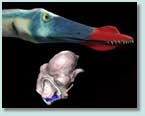 With its 13-foot wing span, a flying dinosaur soars above a lake, scanning for dinner as its shadow glides across the water's surface below. Eying a fish, the aerobatic reptile, called a pterosaur, dives through the air, its shadow shrinking and darkening until – splash! The fish is in the pterosaur's beak, which resembles a cross between a pelican's bill and a crocodile's snout.
While such a scene would have occurred more than 100 million years ago, a study released this week gives a clearer picture of what went on inside the pterosaur's head. When scientists using skull fossils examined the neuroanatomy responsible for flight control and prey spotting, they found key structures to be specialized and enlarged, a discovery that could revise views of how vision, flight, and the brain itself evolved. With its 13-foot wing span, a flying dinosaur soars above a lake, scanning for dinner as its shadow glides across the water's surface below. Eying a fish, the aerobatic reptile, called a pterosaur, dives through the air, its shadow shrinking and darkening until – splash! The fish is in the pterosaur's beak, which resembles a cross between a pelican's bill and a crocodile's snout.
While such a scene would have occurred more than 100 million years ago, a study released this week gives a clearer picture of what went on inside the pterosaur's head. When scientists using skull fossils examined the neuroanatomy responsible for flight control and prey spotting, they found key structures to be specialized and enlarged, a discovery that could revise views of how vision, flight, and the brain itself evolved.
Image: Trent Schindler / National Science Foundation
Read the full story. ... Posted
10/29/03
|
 |
Boundary Between Earth's Magnetic Field and Sun's Solar Wind Riddled with "Swiss Cheese" Holes
|
 |
| |
 Magnetic fields explosively release energy in events throughout the universe, from experiments conducted in laboratories to huge outbursts within galaxies. On the Sun, these magnetic explosions are responsible for solar flares and ejections of material from the Sun's corona. Similar events associated with Earth's magnetic field drive magnetic storms, and the dramatic brightening and expansion of the northern and southern lights, the aurora borealis and aurora australis. The reconnection of twisted and complex lines of magnetic force relates these phenomena to each other.
Scientists have long debated whether the fast release of energy that occurs during "magnetic reconnection" is a smooth or turbulent process. Scientists funded by NSF have now used large-scale computer simulations, combined with direct observations from satellites, to show that the energy release is likely the result of turbulent processes. This knowledge may explain the effect of solar storms on Earth, from interruptions of satellite orbits to electrical outages in cities and towns. Magnetic fields explosively release energy in events throughout the universe, from experiments conducted in laboratories to huge outbursts within galaxies. On the Sun, these magnetic explosions are responsible for solar flares and ejections of material from the Sun's corona. Similar events associated with Earth's magnetic field drive magnetic storms, and the dramatic brightening and expansion of the northern and southern lights, the aurora borealis and aurora australis. The reconnection of twisted and complex lines of magnetic force relates these phenomena to each other.
Scientists have long debated whether the fast release of energy that occurs during "magnetic reconnection" is a smooth or turbulent process. Scientists funded by NSF have now used large-scale computer simulations, combined with direct observations from satellites, to show that the energy release is likely the result of turbulent processes. This knowledge may explain the effect of solar storms on Earth, from interruptions of satellite orbits to electrical outages in cities and towns.
Image: Jonathan Berry, National Science Foundation
Read the full story. ... Posted
10/29/03
|
 |
President Names Eight Elite Scientists and Engineers to Receive National Medals of Science
|
 |
| |
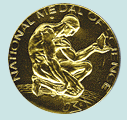 President Bush on Oct. 22 named eight of the nation's leading scientists and engineers to receive the 2002 National Medal of Science for work that spawned many advances in scientific theory and developments leading to new technologies. The presidential medal is the nation’s highest honor for researchers who make major impacts in fields of science and engineering through career-long, ground-breaking achievements and on the individual disciplines for which the awards are given. The medal also recognizes contributions to innovation, industry or education. "The ideas and breakthroughs in fundamental science and engineering by these extraordinary pioneers have influenced thousands of other researchers," NSF director Rita Colwell said. "These amazing people represent overall close to four centuries worth of experience in research, teaching and leadership inside their fields and extending across many other disciplines as well." President Bush on Oct. 22 named eight of the nation's leading scientists and engineers to receive the 2002 National Medal of Science for work that spawned many advances in scientific theory and developments leading to new technologies. The presidential medal is the nation’s highest honor for researchers who make major impacts in fields of science and engineering through career-long, ground-breaking achievements and on the individual disciplines for which the awards are given. The medal also recognizes contributions to innovation, industry or education. "The ideas and breakthroughs in fundamental science and engineering by these extraordinary pioneers have influenced thousands of other researchers," NSF director Rita Colwell said. "These amazing people represent overall close to four centuries worth of experience in research, teaching and leadership inside their fields and extending across many other disciplines as well."
Read the full story. ... Posted
10/22/03
|
 |
NSF Awards $31.9 Million in Grants to Study Biocomplexity in the Environment
|
 |
| |
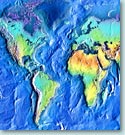 To better understand the interrelationships among living things from molecular structures to genes to ecosystems—and how they interact with their environment—the National Science Foundation has awarded $31.9 million in 30 research grants to scientists and engineers across the country. "These investigations will provide a more complete understanding of natural processes and cycles, of human behaviors and decisions in the natural world, and of ways to use new technology effectively to observe the environment and sustain the diversity of life on Earth," said Rita Colwell, director of NSF. To better understand the interrelationships among living things from molecular structures to genes to ecosystems—and how they interact with their environment—the National Science Foundation has awarded $31.9 million in 30 research grants to scientists and engineers across the country. "These investigations will provide a more complete understanding of natural processes and cycles, of human behaviors and decisions in the natural world, and of ways to use new technology effectively to observe the environment and sustain the diversity of life on Earth," said Rita Colwell, director of NSF.
Image: iStockpro
Read the full story. ... Posted
10/14/03
|
 |
Ecology of Infectious Diseases Grants Awarded by National Science Foundation, National Institutes of Health
|
 |
| |
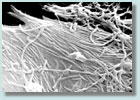 Two government agencies have announced funding for six projects under the Ecology of Infectious Diseases (EID) program, the fourth year of funding in this multi-year effort. The joint NSF and NIH program supports efforts to understand the underlying ecological and biological mechanisms that govern relationships between human-induced environmental changes, and the emergence and transmission of infectious diseases. Interdisciplinary projects funded through the EID program will study how large-scale environmental events—such as habitat destruction, biological invasion and pollution—alter the risks of emergence of viral, parasitic and bacterial diseases in humans and animals."The EID program illustrates the benefits of interagency coordination," says Mary Clutter, NSF assistant director for biological sciences. "It will take combined efforts not only across disciplines, but also across agencies, to understand the ecology of infectious diseases." Two government agencies have announced funding for six projects under the Ecology of Infectious Diseases (EID) program, the fourth year of funding in this multi-year effort. The joint NSF and NIH program supports efforts to understand the underlying ecological and biological mechanisms that govern relationships between human-induced environmental changes, and the emergence and transmission of infectious diseases. Interdisciplinary projects funded through the EID program will study how large-scale environmental events—such as habitat destruction, biological invasion and pollution—alter the risks of emergence of viral, parasitic and bacterial diseases in humans and animals."The EID program illustrates the benefits of interagency coordination," says Mary Clutter, NSF assistant director for biological sciences. "It will take combined efforts not only across disciplines, but also across agencies, to understand the ecology of infectious diseases."
Image courtesy: C. Goldsmith/Centers for Disease Control and Prevention
Read the full story. ... Posted
10/14/03
|
 |
A Moving Experience for the Liberty Bell
|
 |
| |
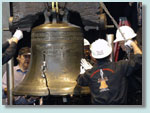 A little after dawn's early light -- 7 A.M., eastern time -- on Oct. 9, the Liberty Bell embarked on a historic, four-hour journey to its new quarters in the Liberty Bell Center in Philadelphia. Wireless sensors developed by Microstrain Inc, a Vermont-based company, were attached to the Bell on Oct. 8 to monitor infinitesimally small vibrations that could endanger the 2,080-pound national icon during the move. The sensors were developed with support from NSF. The new Center is about 300 feet away from the Liberty Bell's former home, but the day's trip covered nearly 1,000 feet over the flattest part of the landscape. A little after dawn's early light -- 7 A.M., eastern time -- on Oct. 9, the Liberty Bell embarked on a historic, four-hour journey to its new quarters in the Liberty Bell Center in Philadelphia. Wireless sensors developed by Microstrain Inc, a Vermont-based company, were attached to the Bell on Oct. 8 to monitor infinitesimally small vibrations that could endanger the 2,080-pound national icon during the move. The sensors were developed with support from NSF. The new Center is about 300 feet away from the Liberty Bell's former home, but the day's trip covered nearly 1,000 feet over the flattest part of the landscape.
Image credit: Peter West/National Science Foundation
For more information, see The Liberty Bell: Protecting an American. ... Posted
10/9/03
|
 |
NSF Grantees Awarded 2003 Nobel Prizes in Economics, Physics and Physiology or Medicine
|
 |
| |
 The Royal Swedish Academy of Sciences on Oct. 7 announced Anthony Leggett, physics professor at the University of Illinois, Urbana-Champaign, was awarded the 2003 Nobel Prize in Physics for groundbreaking work in explaining the behavior of atoms in superfluids. "The National Science Foundation is proud to have supported his research over the past 20 years," said NSF Director Rita R. Colwell in a statement shortly after the award was announced. On Oct. 8, Colwell congratulated Dr. Robert F. Engle, of New York University, and Dr. Clive W. Granger, of University of California-San Diego, for their selection as co-winners of the 2003 Nobel Prize for Economics, noting NSF "has supported the research of both of these distinguished economists for the past quarter century." On Monday, Colwell and NSF Deputy Director Joseph Bordogna congratulated the 2003 Nobel Laureate in physiology or medicine, Professor Paul Lauterbur, on the faculty of the University of Illinois, Urbana-Champaign and also a recipient of NSF support. The Royal Swedish Academy of Sciences on Oct. 7 announced Anthony Leggett, physics professor at the University of Illinois, Urbana-Champaign, was awarded the 2003 Nobel Prize in Physics for groundbreaking work in explaining the behavior of atoms in superfluids. "The National Science Foundation is proud to have supported his research over the past 20 years," said NSF Director Rita R. Colwell in a statement shortly after the award was announced. On Oct. 8, Colwell congratulated Dr. Robert F. Engle, of New York University, and Dr. Clive W. Granger, of University of California-San Diego, for their selection as co-winners of the 2003 Nobel Prize for Economics, noting NSF "has supported the research of both of these distinguished economists for the past quarter century." On Monday, Colwell and NSF Deputy Director Joseph Bordogna congratulated the 2003 Nobel Laureate in physiology or medicine, Professor Paul Lauterbur, on the faculty of the University of Illinois, Urbana-Champaign and also a recipient of NSF support.
Statement on Drs. Engle and Granger
Statement on Dr. Leggett.
Statement on Dr. Lauterbur.
... Posted 10/9/03
|
 |
New Glass Can Replace Expensive Crystals in Some Lasers and Bring
High Power to Small Packages
|
 |
| |
 Researchers have developed a new family of glasses that will bring higher power to smaller packages in lasers and optical devices and provide a less-expensive alternative to many other optical glasses and crystals, like sapphire. Called REAl™ Glass (Rare-earth–Aluminum oxide), the materials are durable, provide a good host for atoms that improve laser performance, and may extend the range of wavelengths that a single laser can currently produce.
With support from the National Science Foundation (NSF), Containerless Research, Inc. (CRI), based in the Northwestern University Evanston Research Park in Illinois, recently developed the REAl™ Glass manufacturing process. NSF is now supporting the company to develop the glasses for applications in power lasers, surgical lasers, optical communications devices, infrared materials, and sensors that may detect explosives and toxins. Researchers have developed a new family of glasses that will bring higher power to smaller packages in lasers and optical devices and provide a less-expensive alternative to many other optical glasses and crystals, like sapphire. Called REAl™ Glass (Rare-earth–Aluminum oxide), the materials are durable, provide a good host for atoms that improve laser performance, and may extend the range of wavelengths that a single laser can currently produce.
With support from the National Science Foundation (NSF), Containerless Research, Inc. (CRI), based in the Northwestern University Evanston Research Park in Illinois, recently developed the REAl™ Glass manufacturing process. NSF is now supporting the company to develop the glasses for applications in power lasers, surgical lasers, optical communications devices, infrared materials, and sensors that may detect explosives and toxins.
Image courtesy: NASA
Read the full story. ... Posted
10/7/03
|
 |
NSF Presents a Symposium on Astronomy and Invites the Public to Participate via the Internet
|
 |
| |
 Some of the nation’s top researchers will explore the 21st century cosmos during an NSF-sponsored symposium, "The Universe from the Ground Up: Ground-Based Astronomy in the 21st Century," on Oct. 7-8, 2003. The public is invited to participate via the Internet. A lecture by Harvard University's Robert Kirshner on the current, remarkable state of excitement in cosmology will be webcast live on Oct. 7. The full day of lectures and panel discussions on Oct. 8 will be available as live streaming audio. Finally, a webcast of University of Arizona astronomer Chris Impey’s talk on "Life and the Universe" will be available on a delayed basis on Oct. 8. Some of the nation’s top researchers will explore the 21st century cosmos during an NSF-sponsored symposium, "The Universe from the Ground Up: Ground-Based Astronomy in the 21st Century," on Oct. 7-8, 2003. The public is invited to participate via the Internet. A lecture by Harvard University's Robert Kirshner on the current, remarkable state of excitement in cosmology will be webcast live on Oct. 7. The full day of lectures and panel discussions on Oct. 8 will be available as live streaming audio. Finally, a webcast of University of Arizona astronomer Chris Impey’s talk on "Life and the Universe" will be available on a delayed basis on Oct. 8.
Photo: Courtesy of Gemini Observatory
Details on Internet events.
Information about the symposium. ... Posted
10/6/03
|
 |
NSF Awards $68 Million For New Engineering Centers
|
 |
| |
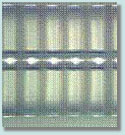 The National Science Foundation announces four new Engineering Research Centers, at an initial estimated NSF investment of $68 million over the next five years. The centers will conduct pioneering research in emerging technologies and train the next generation of engineers. Each center, while based at a university, is a collaborative partnership, drawing together individuals and resources from such entities as universities, industry partners, and state governments. The new centers focus on storm prediction, extreme ultraviolet light, clean chemical manufacturing, and implantable electronics for treating incurable diseases. The National Science Foundation announces four new Engineering Research Centers, at an initial estimated NSF investment of $68 million over the next five years. The centers will conduct pioneering research in emerging technologies and train the next generation of engineers. Each center, while based at a university, is a collaborative partnership, drawing together individuals and resources from such entities as universities, industry partners, and state governments. The new centers focus on storm prediction, extreme ultraviolet light, clean chemical manufacturing, and implantable electronics for treating incurable diseases.
Image: University of Colorado; National Science Foundation
Read the full story. ... Posted
10/3/03
|
 Top of Page Top of Page
|
|
|
 |
 |
 |
 |
 |
 |
 |
 |
|
 |
 |
 |
|
|

